Brunel University: MG5561 Int'l Marketing - Entry Modes Essay
VerifiedAdded on 2023/06/10
|19
|4438
|346
Essay
AI Summary
This essay provides a comprehensive overview of international marketing entry modes, focusing on the advantages and disadvantages of direct, indirect, and export strategies. It differentiates global strategic alliances from traditional entry methods, highlighting their benefits and success factors. Furthermore, the essay examines how the market environment of targeted countries, including market size, competitive structure, and infrastructure, influences the choice of market entry mode. It also considers production and environmental factors, such as raw material costs and government regulations, which impact entry decisions. The document is available on Desklib, a platform offering a wide array of study resources for students.
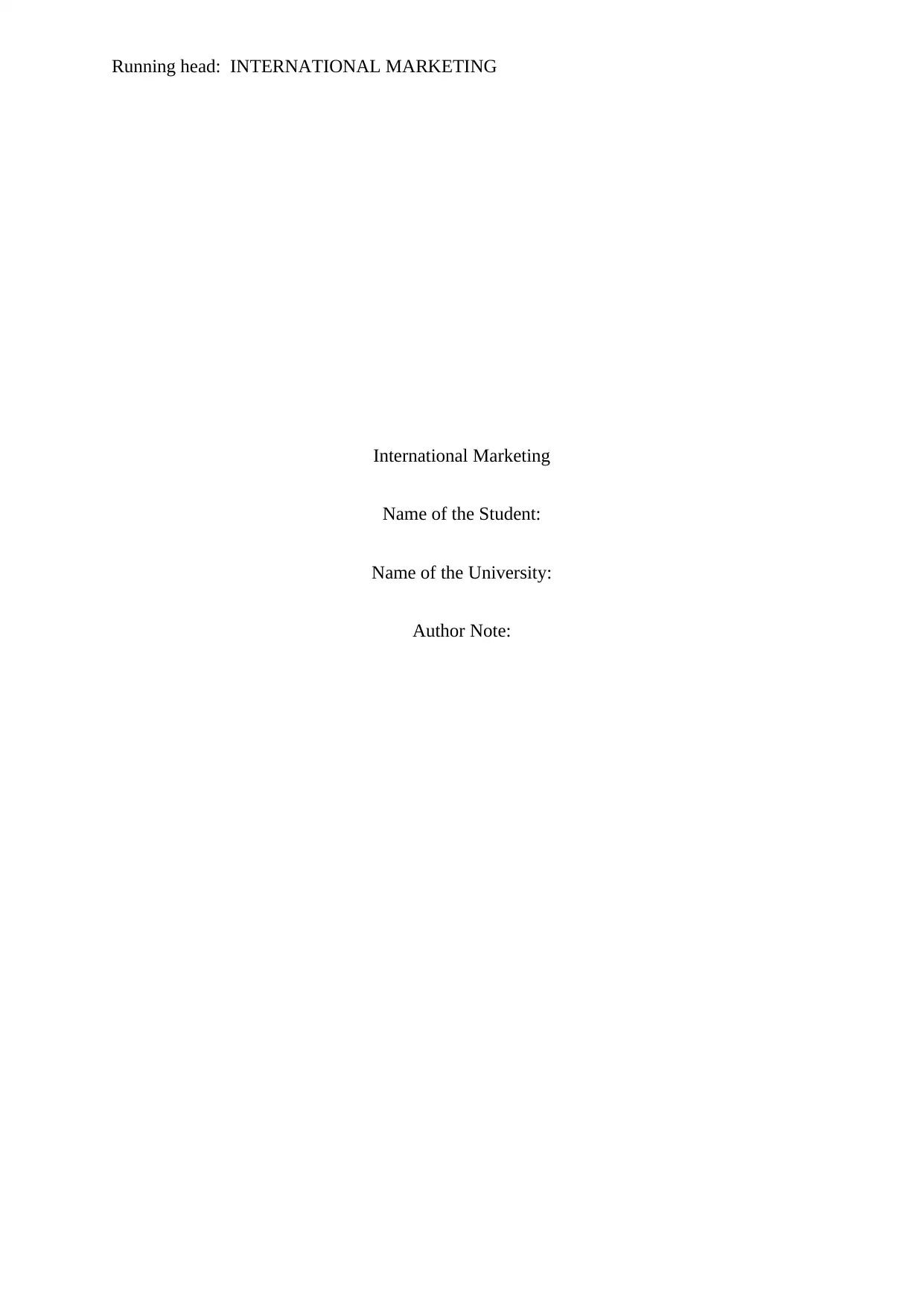
Running head: INTERNATIONAL MARKETING
International Marketing
Name of the Student:
Name of the University:
Author Note:
International Marketing
Name of the Student:
Name of the University:
Author Note:
Paraphrase This Document
Need a fresh take? Get an instant paraphrase of this document with our AI Paraphraser
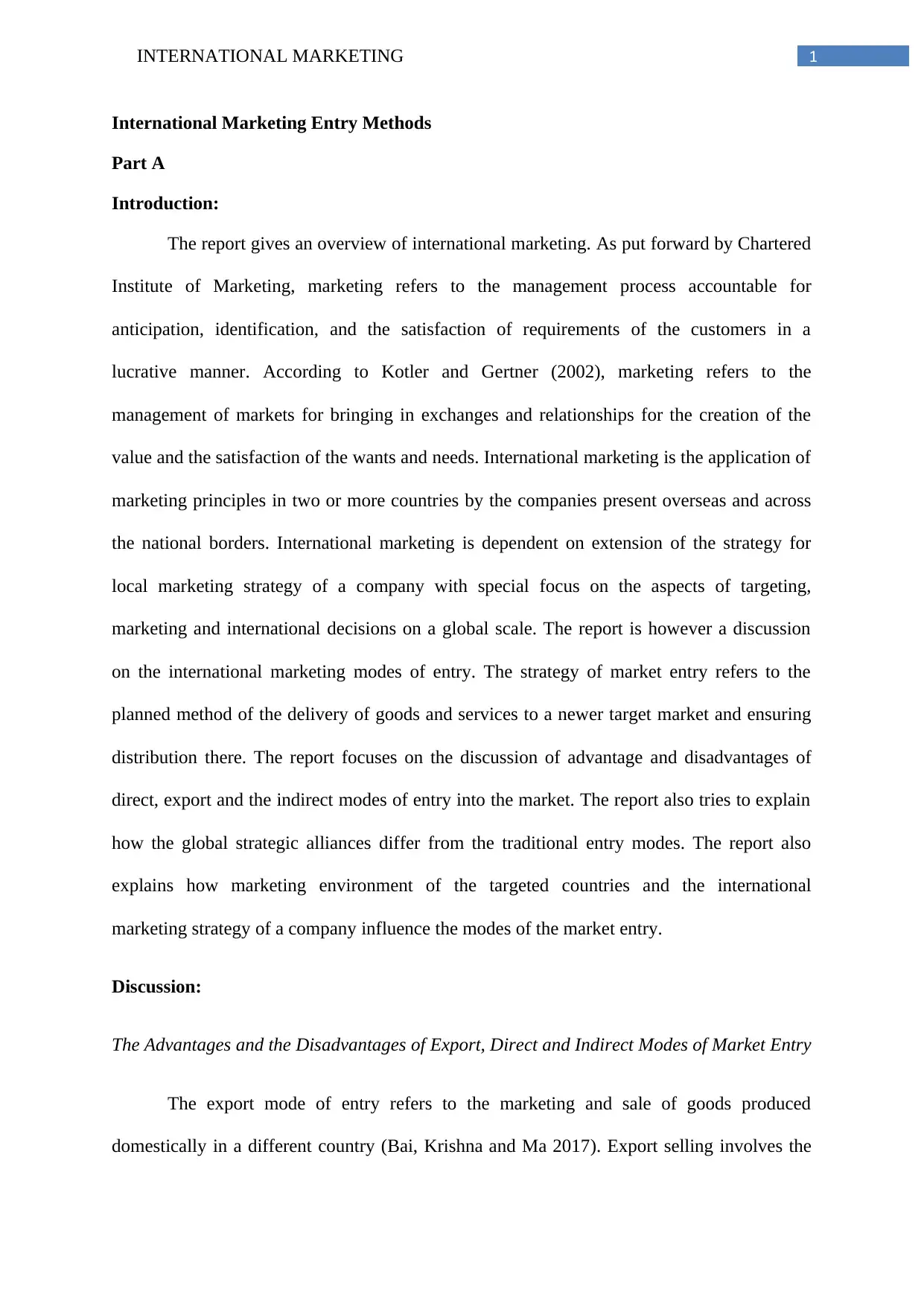
1INTERNATIONAL MARKETING
International Marketing Entry Methods
Part A
Introduction:
The report gives an overview of international marketing. As put forward by Chartered
Institute of Marketing, marketing refers to the management process accountable for
anticipation, identification, and the satisfaction of requirements of the customers in a
lucrative manner. According to Kotler and Gertner (2002), marketing refers to the
management of markets for bringing in exchanges and relationships for the creation of the
value and the satisfaction of the wants and needs. International marketing is the application of
marketing principles in two or more countries by the companies present overseas and across
the national borders. International marketing is dependent on extension of the strategy for
local marketing strategy of a company with special focus on the aspects of targeting,
marketing and international decisions on a global scale. The report is however a discussion
on the international marketing modes of entry. The strategy of market entry refers to the
planned method of the delivery of goods and services to a newer target market and ensuring
distribution there. The report focuses on the discussion of advantage and disadvantages of
direct, export and the indirect modes of entry into the market. The report also tries to explain
how the global strategic alliances differ from the traditional entry modes. The report also
explains how marketing environment of the targeted countries and the international
marketing strategy of a company influence the modes of the market entry.
Discussion:
The Advantages and the Disadvantages of Export, Direct and Indirect Modes of Market Entry
The export mode of entry refers to the marketing and sale of goods produced
domestically in a different country (Bai, Krishna and Ma 2017). Export selling involves the
International Marketing Entry Methods
Part A
Introduction:
The report gives an overview of international marketing. As put forward by Chartered
Institute of Marketing, marketing refers to the management process accountable for
anticipation, identification, and the satisfaction of requirements of the customers in a
lucrative manner. According to Kotler and Gertner (2002), marketing refers to the
management of markets for bringing in exchanges and relationships for the creation of the
value and the satisfaction of the wants and needs. International marketing is the application of
marketing principles in two or more countries by the companies present overseas and across
the national borders. International marketing is dependent on extension of the strategy for
local marketing strategy of a company with special focus on the aspects of targeting,
marketing and international decisions on a global scale. The report is however a discussion
on the international marketing modes of entry. The strategy of market entry refers to the
planned method of the delivery of goods and services to a newer target market and ensuring
distribution there. The report focuses on the discussion of advantage and disadvantages of
direct, export and the indirect modes of entry into the market. The report also tries to explain
how the global strategic alliances differ from the traditional entry modes. The report also
explains how marketing environment of the targeted countries and the international
marketing strategy of a company influence the modes of the market entry.
Discussion:
The Advantages and the Disadvantages of Export, Direct and Indirect Modes of Market Entry
The export mode of entry refers to the marketing and sale of goods produced
domestically in a different country (Bai, Krishna and Ma 2017). Export selling involves the
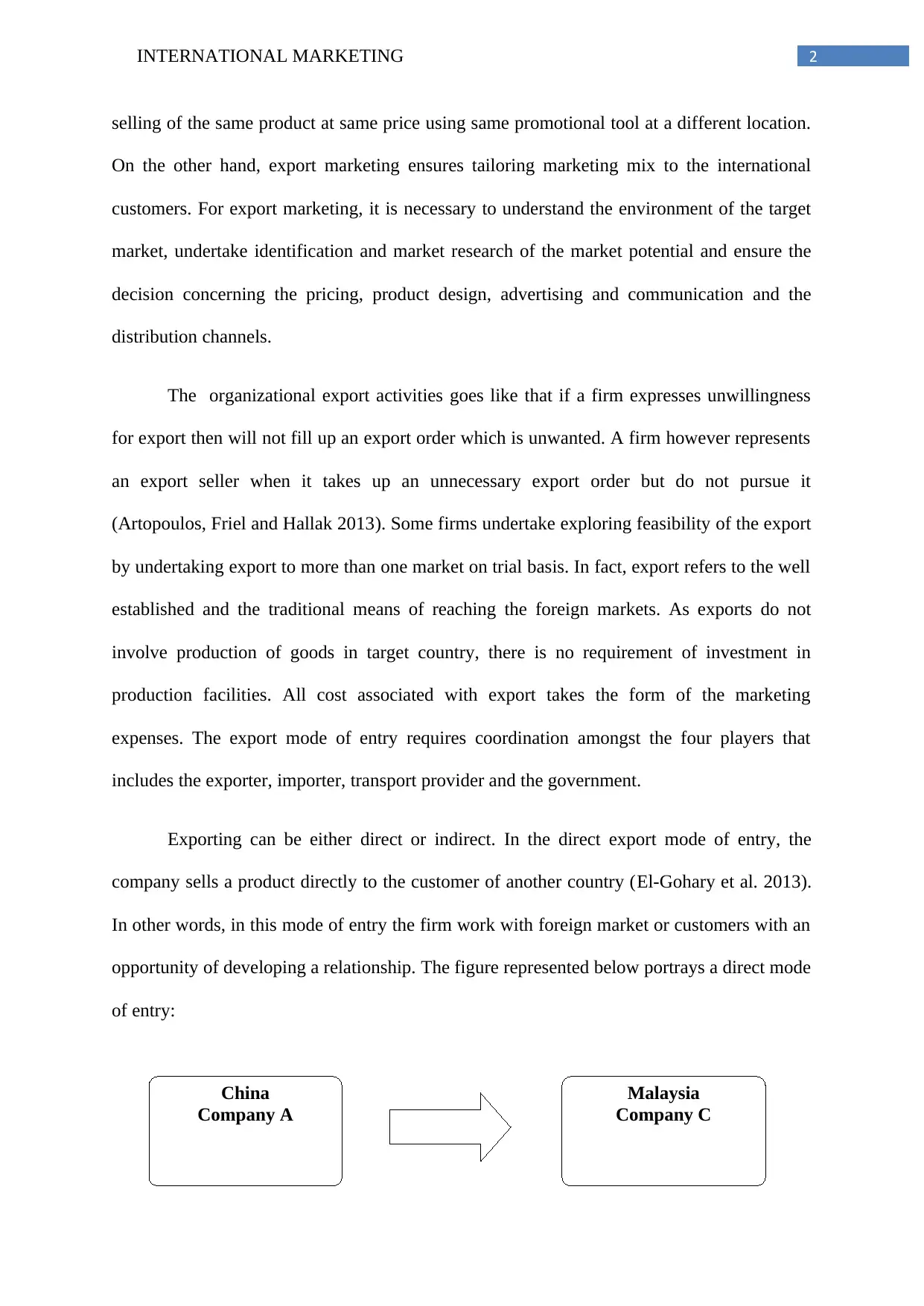
2INTERNATIONAL MARKETING
China
Company A
Malaysia
Company C
selling of the same product at same price using same promotional tool at a different location.
On the other hand, export marketing ensures tailoring marketing mix to the international
customers. For export marketing, it is necessary to understand the environment of the target
market, undertake identification and market research of the market potential and ensure the
decision concerning the pricing, product design, advertising and communication and the
distribution channels.
The organizational export activities goes like that if a firm expresses unwillingness
for export then will not fill up an export order which is unwanted. A firm however represents
an export seller when it takes up an unnecessary export order but do not pursue it
(Artopoulos, Friel and Hallak 2013). Some firms undertake exploring feasibility of the export
by undertaking export to more than one market on trial basis. In fact, export refers to the well
established and the traditional means of reaching the foreign markets. As exports do not
involve production of goods in target country, there is no requirement of investment in
production facilities. All cost associated with export takes the form of the marketing
expenses. The export mode of entry requires coordination amongst the four players that
includes the exporter, importer, transport provider and the government.
Exporting can be either direct or indirect. In the direct export mode of entry, the
company sells a product directly to the customer of another country (El-Gohary et al. 2013).
In other words, in this mode of entry the firm work with foreign market or customers with an
opportunity of developing a relationship. The figure represented below portrays a direct mode
of entry:
China
Company A
Malaysia
Company C
selling of the same product at same price using same promotional tool at a different location.
On the other hand, export marketing ensures tailoring marketing mix to the international
customers. For export marketing, it is necessary to understand the environment of the target
market, undertake identification and market research of the market potential and ensure the
decision concerning the pricing, product design, advertising and communication and the
distribution channels.
The organizational export activities goes like that if a firm expresses unwillingness
for export then will not fill up an export order which is unwanted. A firm however represents
an export seller when it takes up an unnecessary export order but do not pursue it
(Artopoulos, Friel and Hallak 2013). Some firms undertake exploring feasibility of the export
by undertaking export to more than one market on trial basis. In fact, export refers to the well
established and the traditional means of reaching the foreign markets. As exports do not
involve production of goods in target country, there is no requirement of investment in
production facilities. All cost associated with export takes the form of the marketing
expenses. The export mode of entry requires coordination amongst the four players that
includes the exporter, importer, transport provider and the government.
Exporting can be either direct or indirect. In the direct export mode of entry, the
company sells a product directly to the customer of another country (El-Gohary et al. 2013).
In other words, in this mode of entry the firm work with foreign market or customers with an
opportunity of developing a relationship. The figure represented below portrays a direct mode
of entry:
⊘ This is a preview!⊘
Do you want full access?
Subscribe today to unlock all pages.

Trusted by 1+ million students worldwide
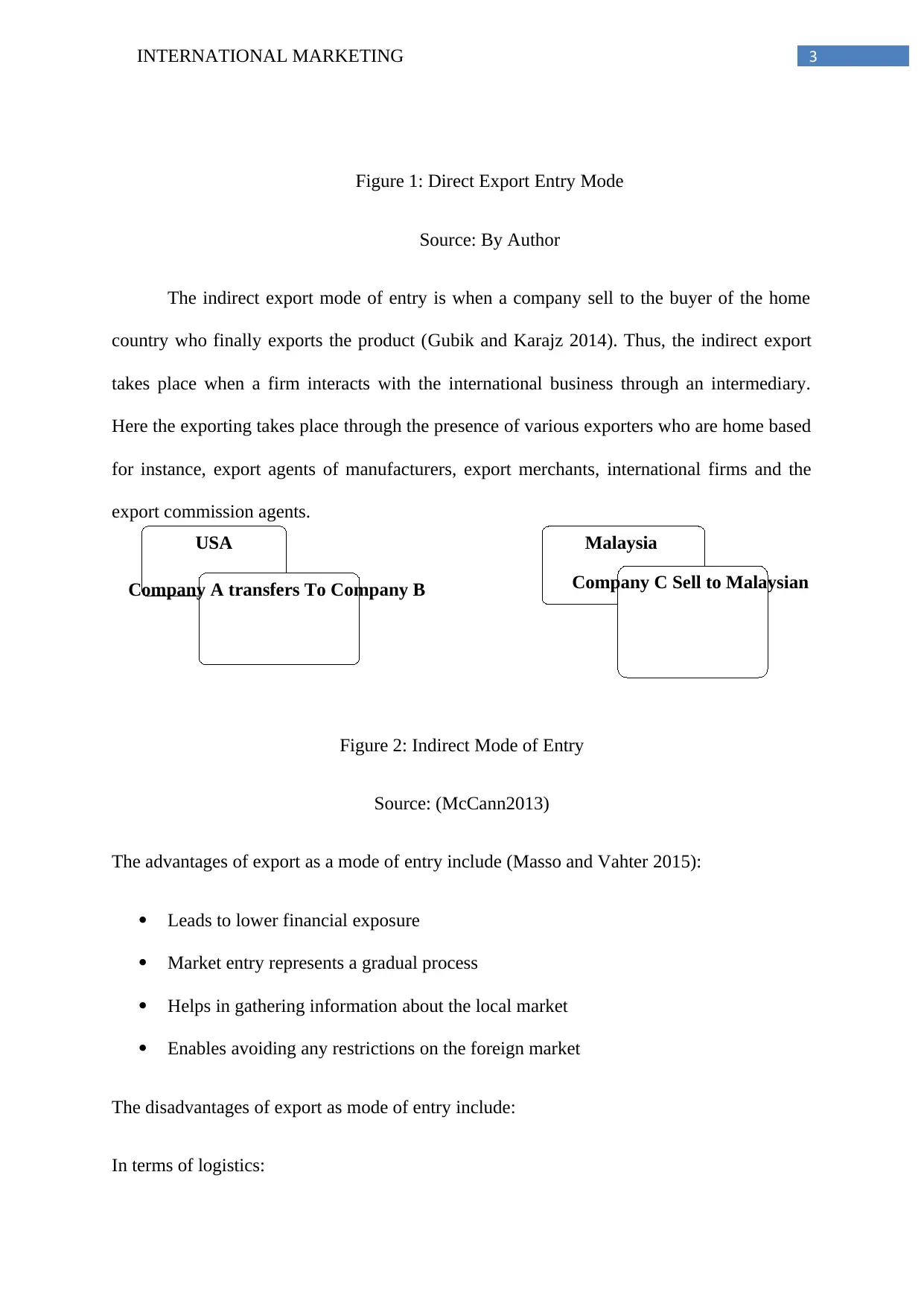
3INTERNATIONAL MARKETING
USA
Company A transfers To Company B
Malaysia
Company C Sell to Malaysian
Figure 1: Direct Export Entry Mode
Source: By Author
The indirect export mode of entry is when a company sell to the buyer of the home
country who finally exports the product (Gubik and Karajz 2014). Thus, the indirect export
takes place when a firm interacts with the international business through an intermediary.
Here the exporting takes place through the presence of various exporters who are home based
for instance, export agents of manufacturers, export merchants, international firms and the
export commission agents.
Figure 2: Indirect Mode of Entry
Source: (McCann2013)
The advantages of export as a mode of entry include (Masso and Vahter 2015):
Leads to lower financial exposure
Market entry represents a gradual process
Helps in gathering information about the local market
Enables avoiding any restrictions on the foreign market
The disadvantages of export as mode of entry include:
In terms of logistics:
USA
Company A transfers To Company B
Malaysia
Company C Sell to Malaysian
Figure 1: Direct Export Entry Mode
Source: By Author
The indirect export mode of entry is when a company sell to the buyer of the home
country who finally exports the product (Gubik and Karajz 2014). Thus, the indirect export
takes place when a firm interacts with the international business through an intermediary.
Here the exporting takes place through the presence of various exporters who are home based
for instance, export agents of manufacturers, export merchants, international firms and the
export commission agents.
Figure 2: Indirect Mode of Entry
Source: (McCann2013)
The advantages of export as a mode of entry include (Masso and Vahter 2015):
Leads to lower financial exposure
Market entry represents a gradual process
Helps in gathering information about the local market
Enables avoiding any restrictions on the foreign market
The disadvantages of export as mode of entry include:
In terms of logistics:
Paraphrase This Document
Need a fresh take? Get an instant paraphrase of this document with our AI Paraphraser
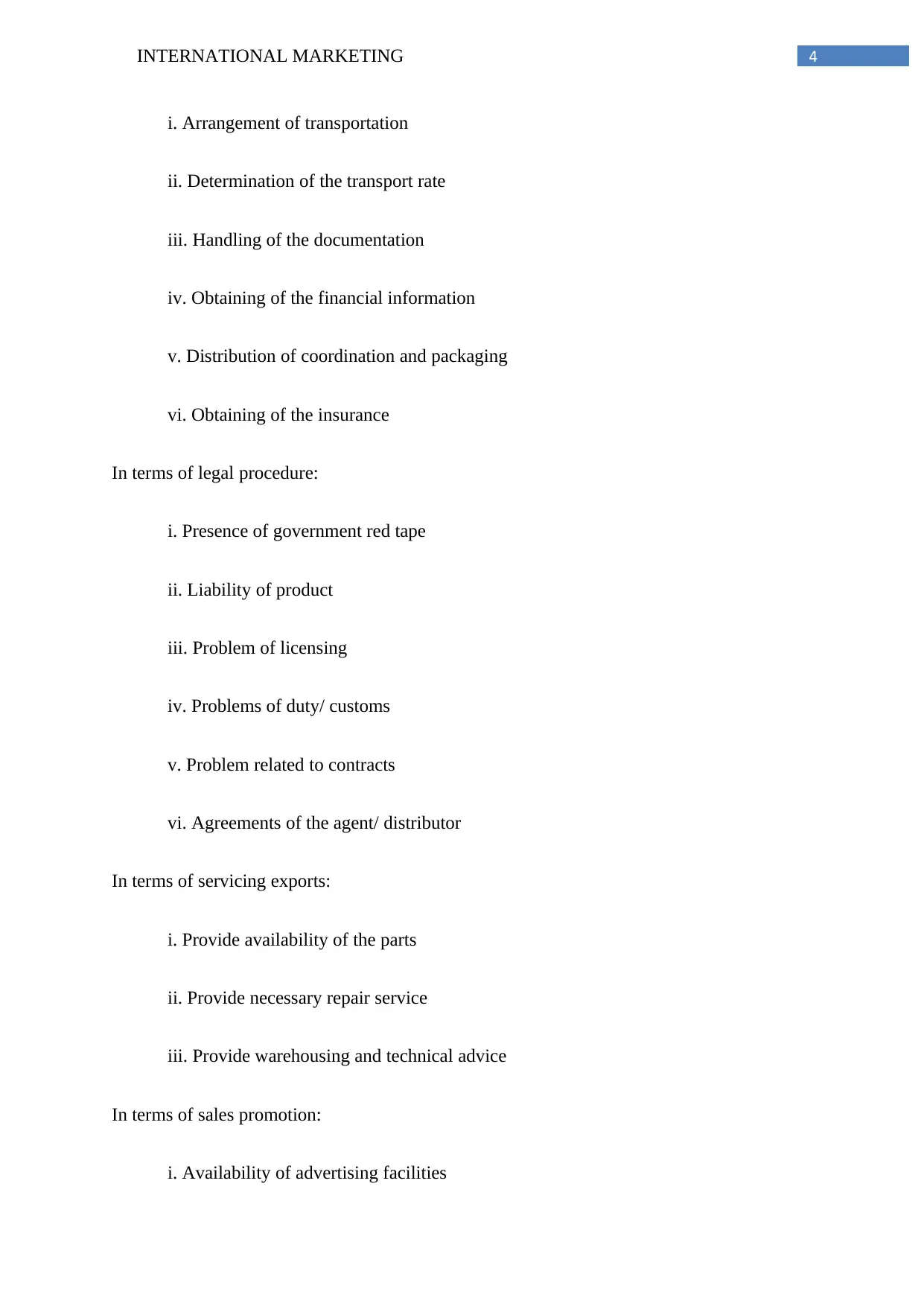
4INTERNATIONAL MARKETING
i. Arrangement of transportation
ii. Determination of the transport rate
iii. Handling of the documentation
iv. Obtaining of the financial information
v. Distribution of coordination and packaging
vi. Obtaining of the insurance
In terms of legal procedure:
i. Presence of government red tape
ii. Liability of product
iii. Problem of licensing
iv. Problems of duty/ customs
v. Problem related to contracts
vi. Agreements of the agent/ distributor
In terms of servicing exports:
i. Provide availability of the parts
ii. Provide necessary repair service
iii. Provide warehousing and technical advice
In terms of sales promotion:
i. Availability of advertising facilities
i. Arrangement of transportation
ii. Determination of the transport rate
iii. Handling of the documentation
iv. Obtaining of the financial information
v. Distribution of coordination and packaging
vi. Obtaining of the insurance
In terms of legal procedure:
i. Presence of government red tape
ii. Liability of product
iii. Problem of licensing
iv. Problems of duty/ customs
v. Problem related to contracts
vi. Agreements of the agent/ distributor
In terms of servicing exports:
i. Provide availability of the parts
ii. Provide necessary repair service
iii. Provide warehousing and technical advice
In terms of sales promotion:
i. Availability of advertising facilities
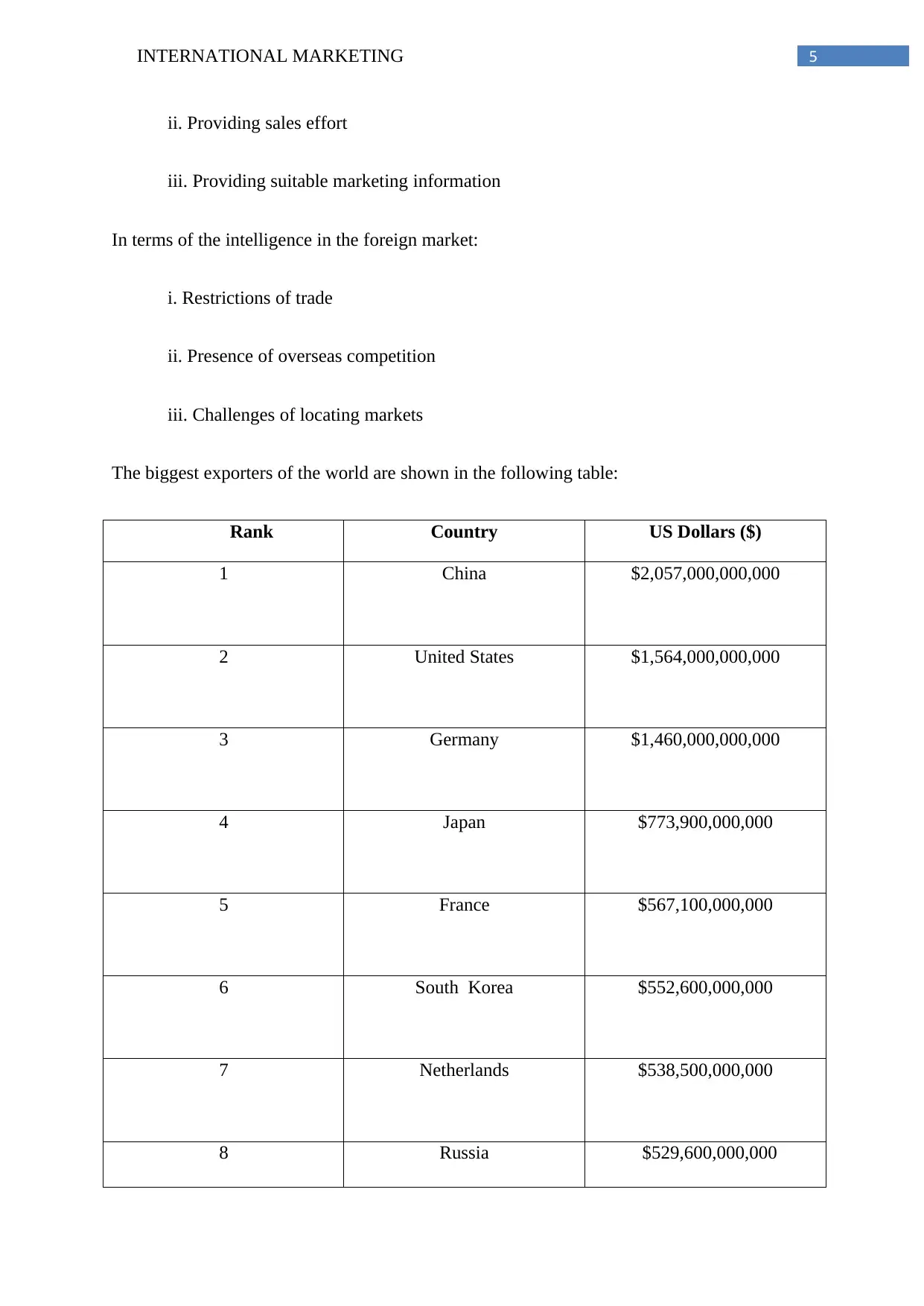
5INTERNATIONAL MARKETING
ii. Providing sales effort
iii. Providing suitable marketing information
In terms of the intelligence in the foreign market:
i. Restrictions of trade
ii. Presence of overseas competition
iii. Challenges of locating markets
The biggest exporters of the world are shown in the following table:
Rank Country US Dollars ($)
1 China $2,057,000,000,000
2 United States $1,564,000,000,000
3 Germany $1,460,000,000,000
4 Japan $773,900,000,000
5 France $567,100,000,000
6 South Korea $552,600,000,000
7 Netherlands $538,500,000,000
8 Russia $529,600,000,000
ii. Providing sales effort
iii. Providing suitable marketing information
In terms of the intelligence in the foreign market:
i. Restrictions of trade
ii. Presence of overseas competition
iii. Challenges of locating markets
The biggest exporters of the world are shown in the following table:
Rank Country US Dollars ($)
1 China $2,057,000,000,000
2 United States $1,564,000,000,000
3 Germany $1,460,000,000,000
4 Japan $773,900,000,000
5 France $567,100,000,000
6 South Korea $552,600,000,000
7 Netherlands $538,500,000,000
8 Russia $529,600,000,000
⊘ This is a preview!⊘
Do you want full access?
Subscribe today to unlock all pages.

Trusted by 1+ million students worldwide
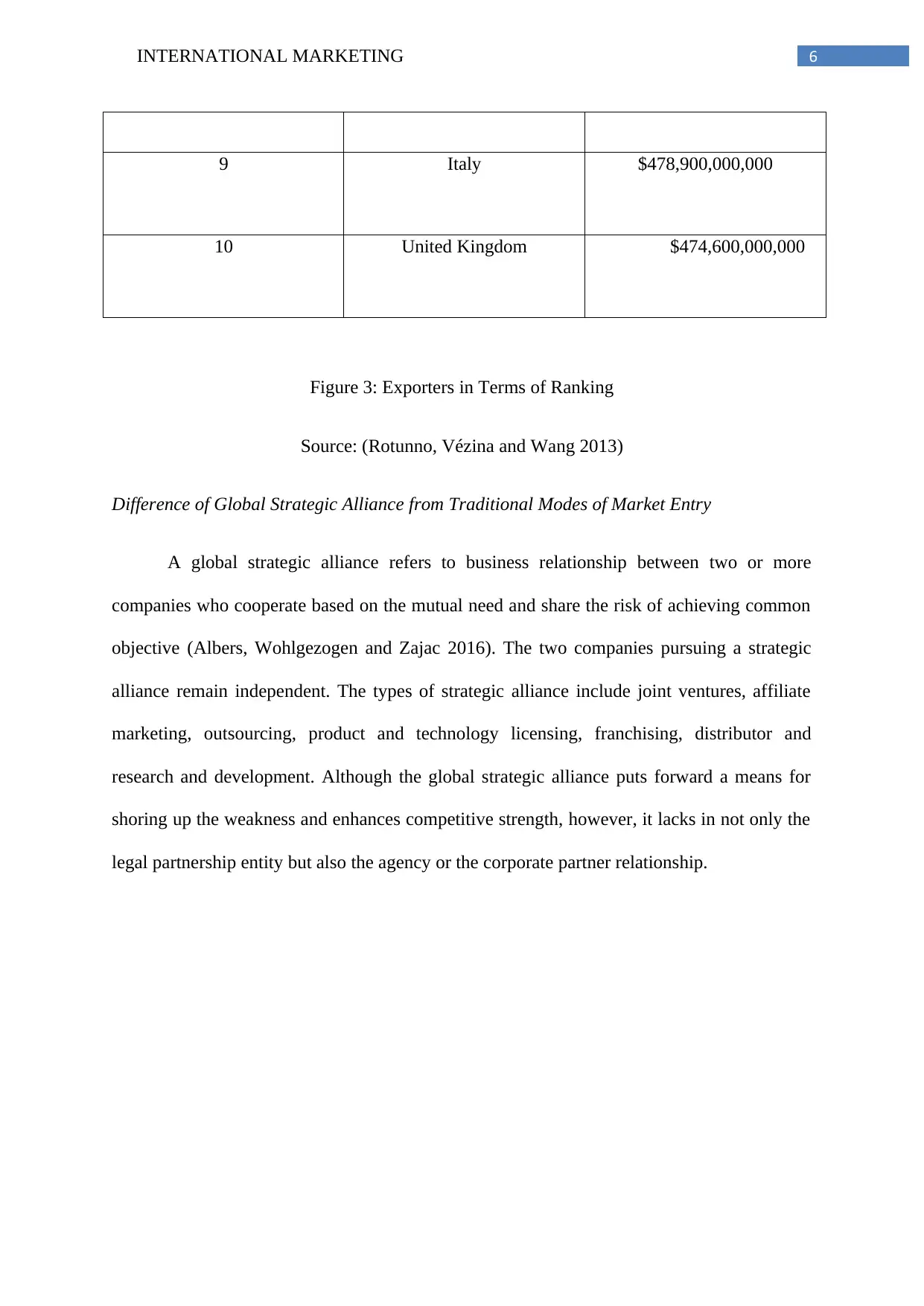
6INTERNATIONAL MARKETING
9 Italy $478,900,000,000
10 United Kingdom $474,600,000,000
Figure 3: Exporters in Terms of Ranking
Source: (Rotunno, Vézina and Wang 2013)
Difference of Global Strategic Alliance from Traditional Modes of Market Entry
A global strategic alliance refers to business relationship between two or more
companies who cooperate based on the mutual need and share the risk of achieving common
objective (Albers, Wohlgezogen and Zajac 2016). The two companies pursuing a strategic
alliance remain independent. The types of strategic alliance include joint ventures, affiliate
marketing, outsourcing, product and technology licensing, franchising, distributor and
research and development. Although the global strategic alliance puts forward a means for
shoring up the weakness and enhances competitive strength, however, it lacks in not only the
legal partnership entity but also the agency or the corporate partner relationship.
9 Italy $478,900,000,000
10 United Kingdom $474,600,000,000
Figure 3: Exporters in Terms of Ranking
Source: (Rotunno, Vézina and Wang 2013)
Difference of Global Strategic Alliance from Traditional Modes of Market Entry
A global strategic alliance refers to business relationship between two or more
companies who cooperate based on the mutual need and share the risk of achieving common
objective (Albers, Wohlgezogen and Zajac 2016). The two companies pursuing a strategic
alliance remain independent. The types of strategic alliance include joint ventures, affiliate
marketing, outsourcing, product and technology licensing, franchising, distributor and
research and development. Although the global strategic alliance puts forward a means for
shoring up the weakness and enhances competitive strength, however, it lacks in not only the
legal partnership entity but also the agency or the corporate partner relationship.
Paraphrase This Document
Need a fresh take? Get an instant paraphrase of this document with our AI Paraphraser
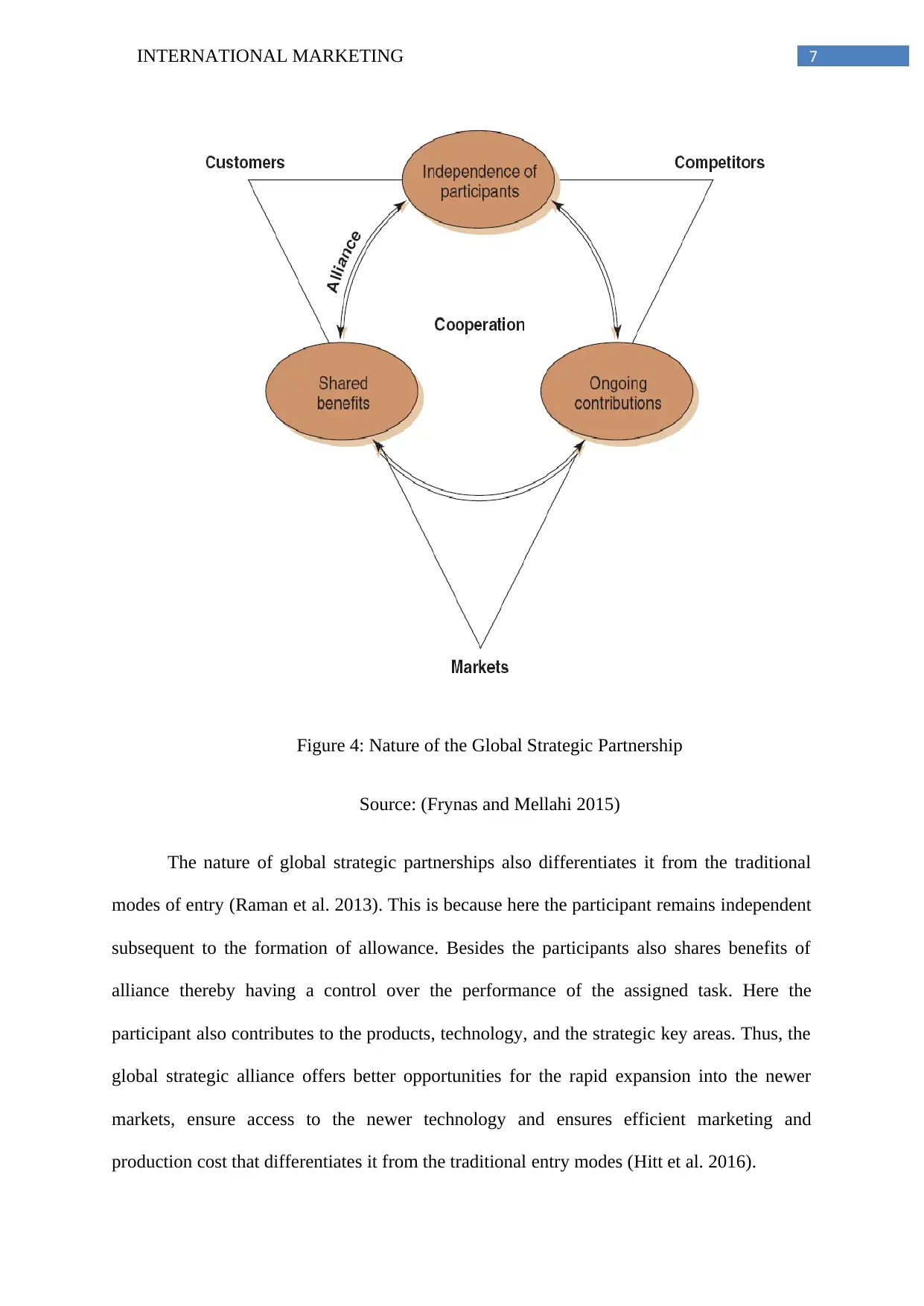
7INTERNATIONAL MARKETING
Figure 4: Nature of the Global Strategic Partnership
Source: (Frynas and Mellahi 2015)
The nature of global strategic partnerships also differentiates it from the traditional
modes of entry (Raman et al. 2013). This is because here the participant remains independent
subsequent to the formation of allowance. Besides the participants also shares benefits of
alliance thereby having a control over the performance of the assigned task. Here the
participant also contributes to the products, technology, and the strategic key areas. Thus, the
global strategic alliance offers better opportunities for the rapid expansion into the newer
markets, ensure access to the newer technology and ensures efficient marketing and
production cost that differentiates it from the traditional entry modes (Hitt et al. 2016).
Figure 4: Nature of the Global Strategic Partnership
Source: (Frynas and Mellahi 2015)
The nature of global strategic partnerships also differentiates it from the traditional
modes of entry (Raman et al. 2013). This is because here the participant remains independent
subsequent to the formation of allowance. Besides the participants also shares benefits of
alliance thereby having a control over the performance of the assigned task. Here the
participant also contributes to the products, technology, and the strategic key areas. Thus, the
global strategic alliance offers better opportunities for the rapid expansion into the newer
markets, ensure access to the newer technology and ensures efficient marketing and
production cost that differentiates it from the traditional entry modes (Hitt et al. 2016).
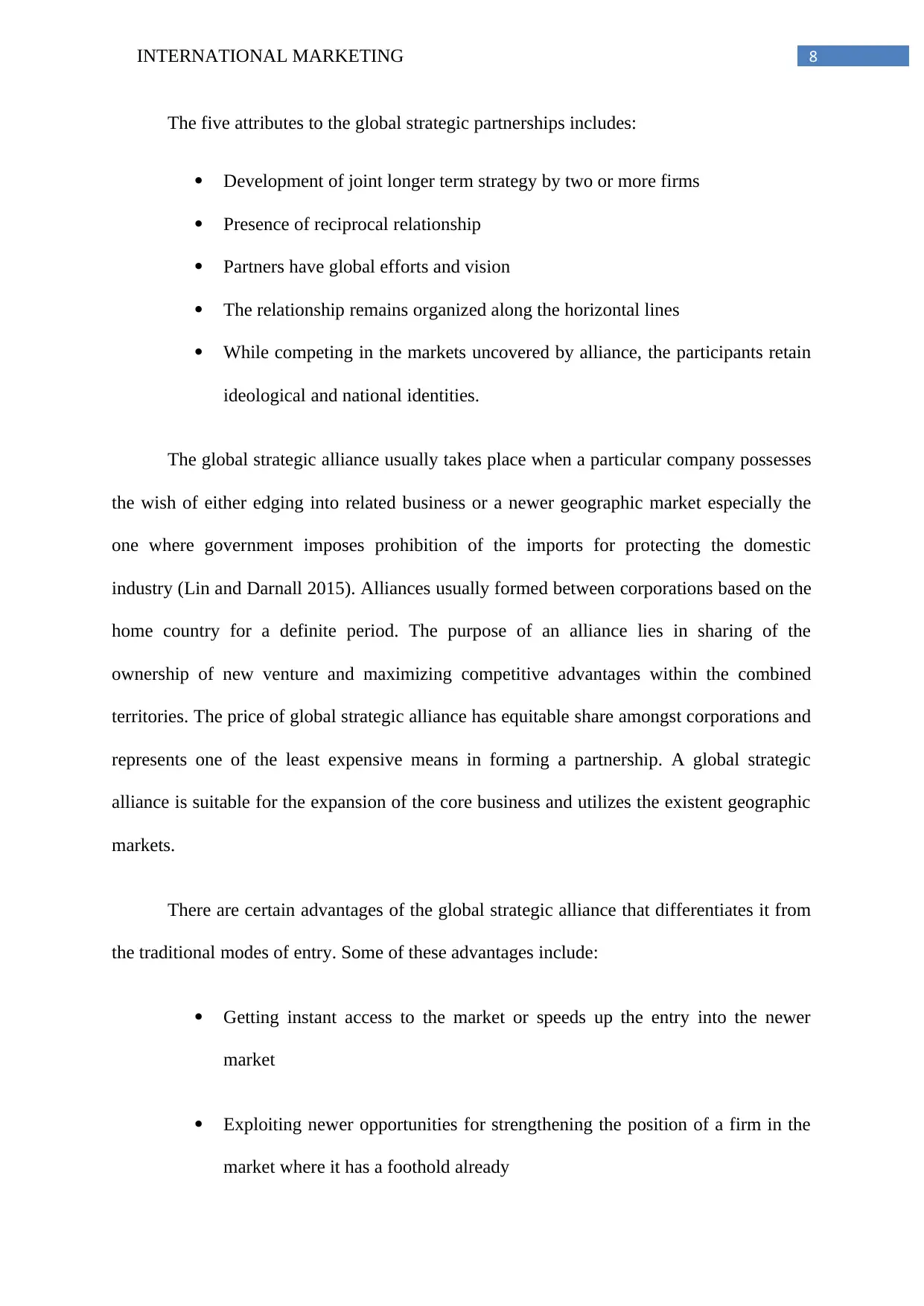
8INTERNATIONAL MARKETING
The five attributes to the global strategic partnerships includes:
Development of joint longer term strategy by two or more firms
Presence of reciprocal relationship
Partners have global efforts and vision
The relationship remains organized along the horizontal lines
While competing in the markets uncovered by alliance, the participants retain
ideological and national identities.
The global strategic alliance usually takes place when a particular company possesses
the wish of either edging into related business or a newer geographic market especially the
one where government imposes prohibition of the imports for protecting the domestic
industry (Lin and Darnall 2015). Alliances usually formed between corporations based on the
home country for a definite period. The purpose of an alliance lies in sharing of the
ownership of new venture and maximizing competitive advantages within the combined
territories. The price of global strategic alliance has equitable share amongst corporations and
represents one of the least expensive means in forming a partnership. A global strategic
alliance is suitable for the expansion of the core business and utilizes the existent geographic
markets.
There are certain advantages of the global strategic alliance that differentiates it from
the traditional modes of entry. Some of these advantages include:
Getting instant access to the market or speeds up the entry into the newer
market
Exploiting newer opportunities for strengthening the position of a firm in the
market where it has a foothold already
The five attributes to the global strategic partnerships includes:
Development of joint longer term strategy by two or more firms
Presence of reciprocal relationship
Partners have global efforts and vision
The relationship remains organized along the horizontal lines
While competing in the markets uncovered by alliance, the participants retain
ideological and national identities.
The global strategic alliance usually takes place when a particular company possesses
the wish of either edging into related business or a newer geographic market especially the
one where government imposes prohibition of the imports for protecting the domestic
industry (Lin and Darnall 2015). Alliances usually formed between corporations based on the
home country for a definite period. The purpose of an alliance lies in sharing of the
ownership of new venture and maximizing competitive advantages within the combined
territories. The price of global strategic alliance has equitable share amongst corporations and
represents one of the least expensive means in forming a partnership. A global strategic
alliance is suitable for the expansion of the core business and utilizes the existent geographic
markets.
There are certain advantages of the global strategic alliance that differentiates it from
the traditional modes of entry. Some of these advantages include:
Getting instant access to the market or speeds up the entry into the newer
market
Exploiting newer opportunities for strengthening the position of a firm in the
market where it has a foothold already
⊘ This is a preview!⊘
Do you want full access?
Subscribe today to unlock all pages.

Trusted by 1+ million students worldwide
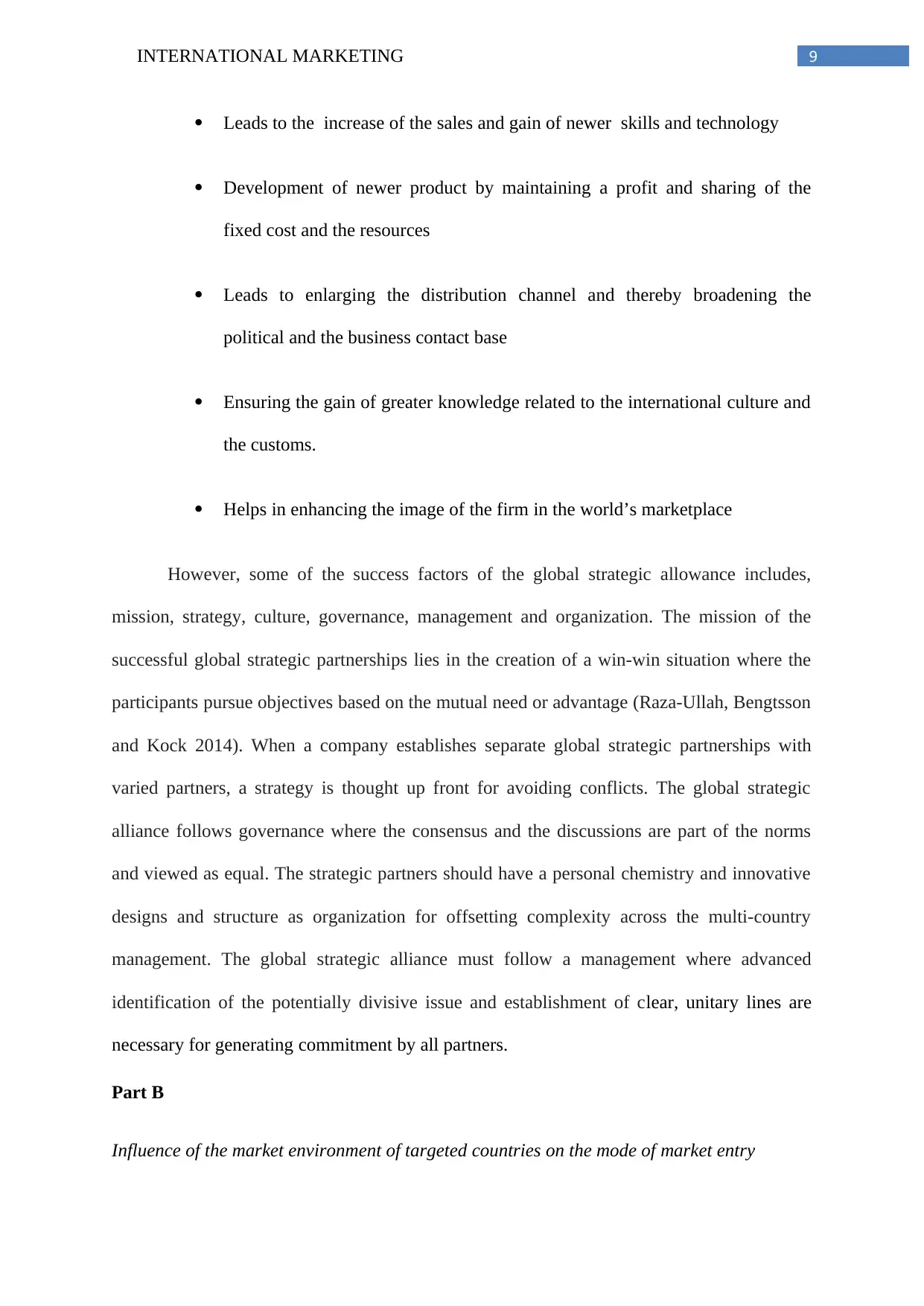
9INTERNATIONAL MARKETING
Leads to the increase of the sales and gain of newer skills and technology
Development of newer product by maintaining a profit and sharing of the
fixed cost and the resources
Leads to enlarging the distribution channel and thereby broadening the
political and the business contact base
Ensuring the gain of greater knowledge related to the international culture and
the customs.
Helps in enhancing the image of the firm in the world’s marketplace
However, some of the success factors of the global strategic allowance includes,
mission, strategy, culture, governance, management and organization. The mission of the
successful global strategic partnerships lies in the creation of a win-win situation where the
participants pursue objectives based on the mutual need or advantage (Raza-Ullah, Bengtsson
and Kock 2014). When a company establishes separate global strategic partnerships with
varied partners, a strategy is thought up front for avoiding conflicts. The global strategic
alliance follows governance where the consensus and the discussions are part of the norms
and viewed as equal. The strategic partners should have a personal chemistry and innovative
designs and structure as organization for offsetting complexity across the multi-country
management. The global strategic alliance must follow a management where advanced
identification of the potentially divisive issue and establishment of clear, unitary lines are
necessary for generating commitment by all partners.
Part B
Influence of the market environment of targeted countries on the mode of market entry
Leads to the increase of the sales and gain of newer skills and technology
Development of newer product by maintaining a profit and sharing of the
fixed cost and the resources
Leads to enlarging the distribution channel and thereby broadening the
political and the business contact base
Ensuring the gain of greater knowledge related to the international culture and
the customs.
Helps in enhancing the image of the firm in the world’s marketplace
However, some of the success factors of the global strategic allowance includes,
mission, strategy, culture, governance, management and organization. The mission of the
successful global strategic partnerships lies in the creation of a win-win situation where the
participants pursue objectives based on the mutual need or advantage (Raza-Ullah, Bengtsson
and Kock 2014). When a company establishes separate global strategic partnerships with
varied partners, a strategy is thought up front for avoiding conflicts. The global strategic
alliance follows governance where the consensus and the discussions are part of the norms
and viewed as equal. The strategic partners should have a personal chemistry and innovative
designs and structure as organization for offsetting complexity across the multi-country
management. The global strategic alliance must follow a management where advanced
identification of the potentially divisive issue and establishment of clear, unitary lines are
necessary for generating commitment by all partners.
Part B
Influence of the market environment of targeted countries on the mode of market entry
Paraphrase This Document
Need a fresh take? Get an instant paraphrase of this document with our AI Paraphraser
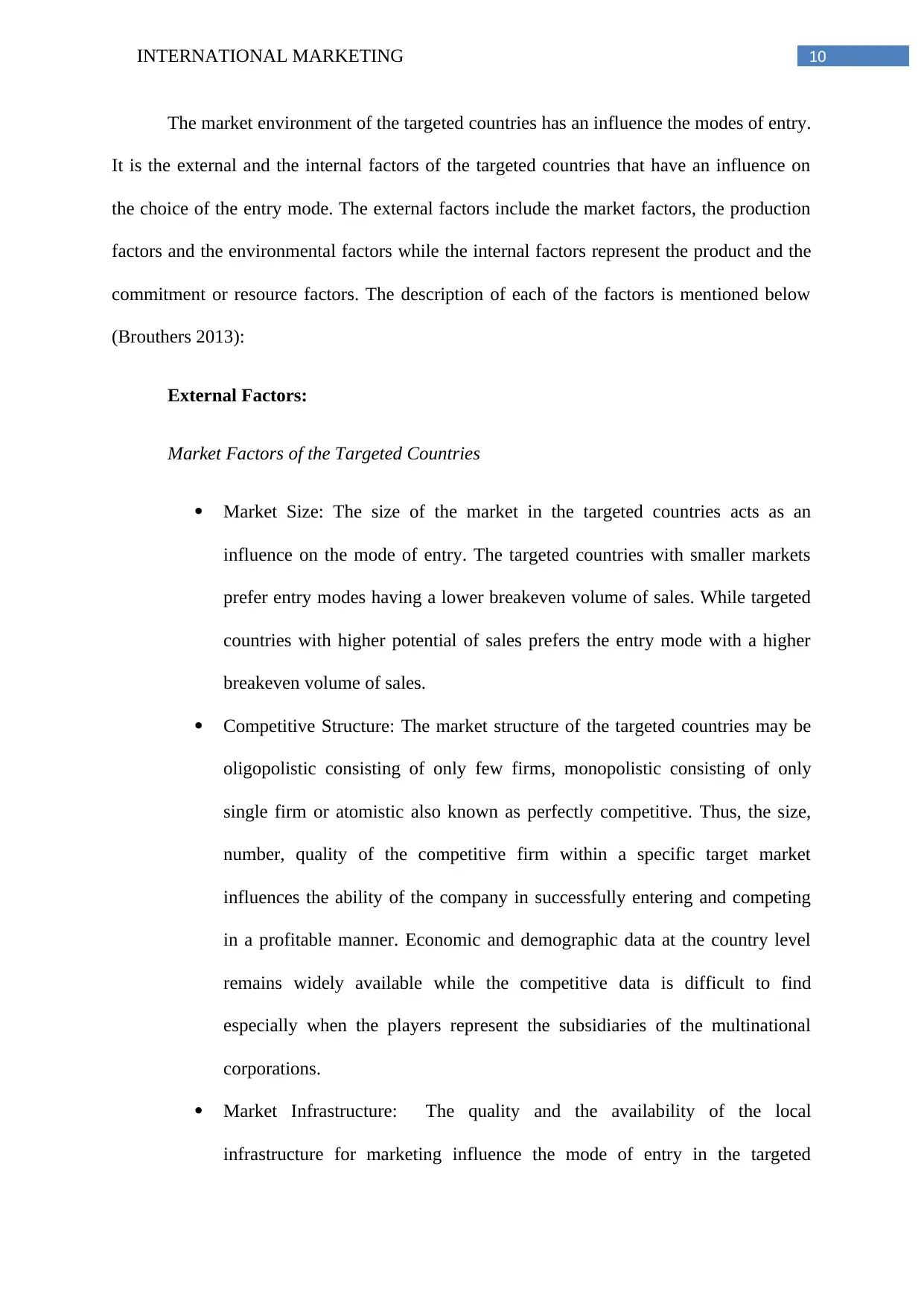
10INTERNATIONAL MARKETING
The market environment of the targeted countries has an influence the modes of entry.
It is the external and the internal factors of the targeted countries that have an influence on
the choice of the entry mode. The external factors include the market factors, the production
factors and the environmental factors while the internal factors represent the product and the
commitment or resource factors. The description of each of the factors is mentioned below
(Brouthers 2013):
External Factors:
Market Factors of the Targeted Countries
Market Size: The size of the market in the targeted countries acts as an
influence on the mode of entry. The targeted countries with smaller markets
prefer entry modes having a lower breakeven volume of sales. While targeted
countries with higher potential of sales prefers the entry mode with a higher
breakeven volume of sales.
Competitive Structure: The market structure of the targeted countries may be
oligopolistic consisting of only few firms, monopolistic consisting of only
single firm or atomistic also known as perfectly competitive. Thus, the size,
number, quality of the competitive firm within a specific target market
influences the ability of the company in successfully entering and competing
in a profitable manner. Economic and demographic data at the country level
remains widely available while the competitive data is difficult to find
especially when the players represent the subsidiaries of the multinational
corporations.
Market Infrastructure: The quality and the availability of the local
infrastructure for marketing influence the mode of entry in the targeted
The market environment of the targeted countries has an influence the modes of entry.
It is the external and the internal factors of the targeted countries that have an influence on
the choice of the entry mode. The external factors include the market factors, the production
factors and the environmental factors while the internal factors represent the product and the
commitment or resource factors. The description of each of the factors is mentioned below
(Brouthers 2013):
External Factors:
Market Factors of the Targeted Countries
Market Size: The size of the market in the targeted countries acts as an
influence on the mode of entry. The targeted countries with smaller markets
prefer entry modes having a lower breakeven volume of sales. While targeted
countries with higher potential of sales prefers the entry mode with a higher
breakeven volume of sales.
Competitive Structure: The market structure of the targeted countries may be
oligopolistic consisting of only few firms, monopolistic consisting of only
single firm or atomistic also known as perfectly competitive. Thus, the size,
number, quality of the competitive firm within a specific target market
influences the ability of the company in successfully entering and competing
in a profitable manner. Economic and demographic data at the country level
remains widely available while the competitive data is difficult to find
especially when the players represent the subsidiaries of the multinational
corporations.
Market Infrastructure: The quality and the availability of the local
infrastructure for marketing influence the mode of entry in the targeted
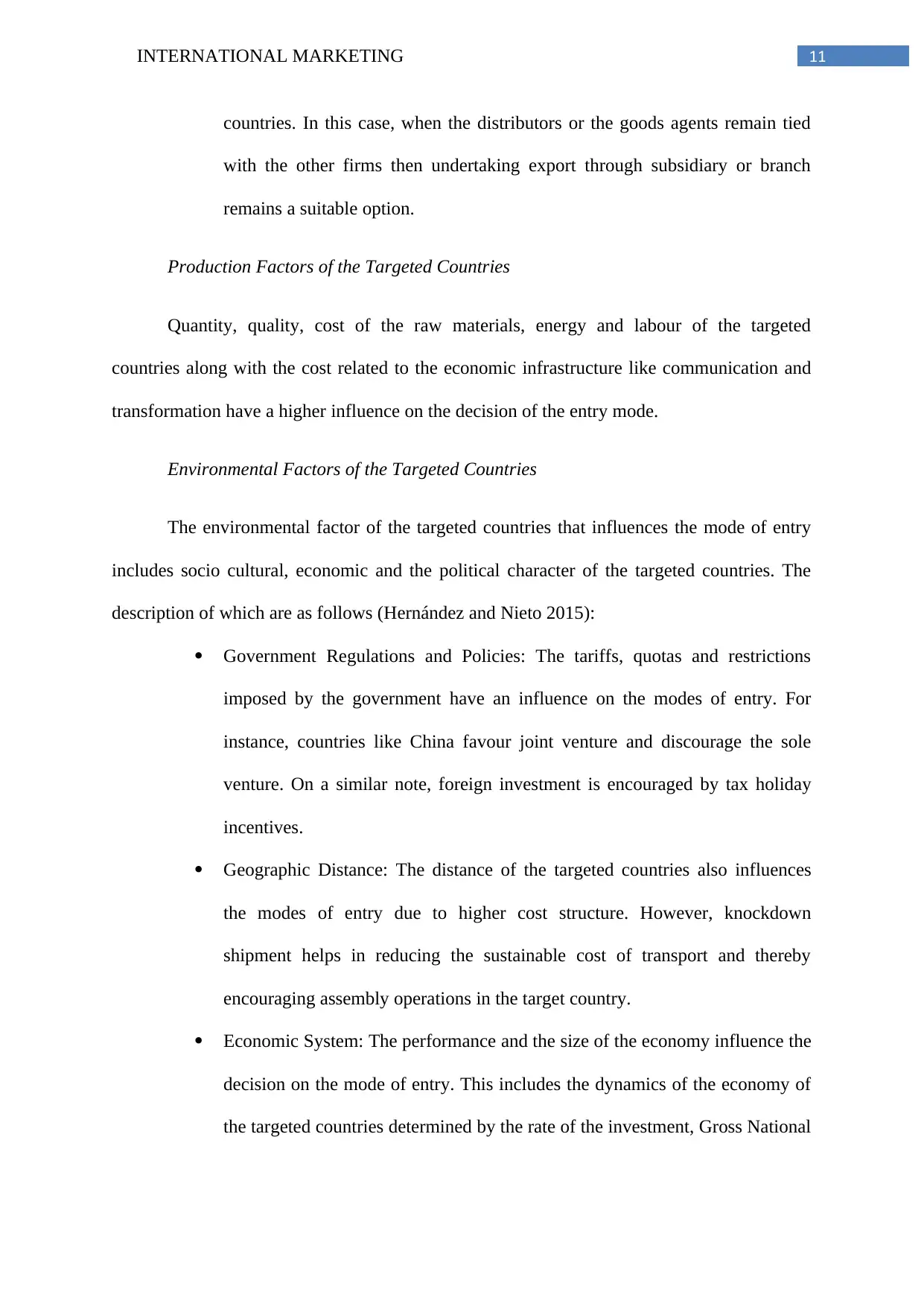
11INTERNATIONAL MARKETING
countries. In this case, when the distributors or the goods agents remain tied
with the other firms then undertaking export through subsidiary or branch
remains a suitable option.
Production Factors of the Targeted Countries
Quantity, quality, cost of the raw materials, energy and labour of the targeted
countries along with the cost related to the economic infrastructure like communication and
transformation have a higher influence on the decision of the entry mode.
Environmental Factors of the Targeted Countries
The environmental factor of the targeted countries that influences the mode of entry
includes socio cultural, economic and the political character of the targeted countries. The
description of which are as follows (Hernández and Nieto 2015):
Government Regulations and Policies: The tariffs, quotas and restrictions
imposed by the government have an influence on the modes of entry. For
instance, countries like China favour joint venture and discourage the sole
venture. On a similar note, foreign investment is encouraged by tax holiday
incentives.
Geographic Distance: The distance of the targeted countries also influences
the modes of entry due to higher cost structure. However, knockdown
shipment helps in reducing the sustainable cost of transport and thereby
encouraging assembly operations in the target country.
Economic System: The performance and the size of the economy influence the
decision on the mode of entry. This includes the dynamics of the economy of
the targeted countries determined by the rate of the investment, Gross National
countries. In this case, when the distributors or the goods agents remain tied
with the other firms then undertaking export through subsidiary or branch
remains a suitable option.
Production Factors of the Targeted Countries
Quantity, quality, cost of the raw materials, energy and labour of the targeted
countries along with the cost related to the economic infrastructure like communication and
transformation have a higher influence on the decision of the entry mode.
Environmental Factors of the Targeted Countries
The environmental factor of the targeted countries that influences the mode of entry
includes socio cultural, economic and the political character of the targeted countries. The
description of which are as follows (Hernández and Nieto 2015):
Government Regulations and Policies: The tariffs, quotas and restrictions
imposed by the government have an influence on the modes of entry. For
instance, countries like China favour joint venture and discourage the sole
venture. On a similar note, foreign investment is encouraged by tax holiday
incentives.
Geographic Distance: The distance of the targeted countries also influences
the modes of entry due to higher cost structure. However, knockdown
shipment helps in reducing the sustainable cost of transport and thereby
encouraging assembly operations in the target country.
Economic System: The performance and the size of the economy influence the
decision on the mode of entry. This includes the dynamics of the economy of
the targeted countries determined by the rate of the investment, Gross National
⊘ This is a preview!⊘
Do you want full access?
Subscribe today to unlock all pages.

Trusted by 1+ million students worldwide
1 out of 19
Related Documents
Your All-in-One AI-Powered Toolkit for Academic Success.
+13062052269
info@desklib.com
Available 24*7 on WhatsApp / Email
![[object Object]](/_next/static/media/star-bottom.7253800d.svg)
Unlock your academic potential
Copyright © 2020–2025 A2Z Services. All Rights Reserved. Developed and managed by ZUCOL.





